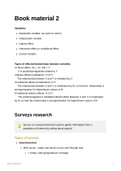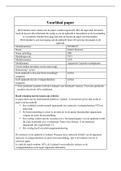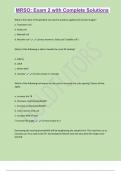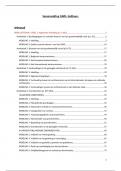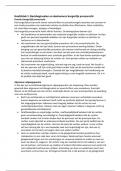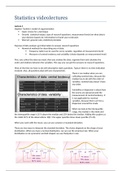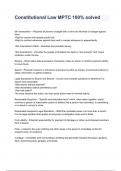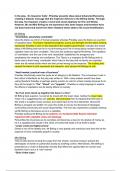Book material 2
Variables:
Dependent variable -we want to control
Independent variable
Indirect effect
Interaction effect or conditional effect
Control variable
Types of effects/relationships between variables
•A direct effect: X1 (, X2, X3) > Y
X is positively/negatively related to Y
•Indirect effects (mediation): X>Z>Y
The relationship between X and Y is mediated by Z
•Conditional effects (moderation): X>Y
The relationship between X and Y is moderated by M, so that this relationship is
stronger/weaker for higher/lower values of M
•Conditional indirect effects: X>Z>Y
The positive/negative Z mediated indirect effect between X and Y is moderated
by M, so that this relationship is stronger/weaker for higher/lower values of M
Surveys research
💡 Survey is a measurement tool used to gather information from a
population of interest by asking about topic(s)
Types of surveys
1. Questionnaires
Mail survey - paper and pencil survey sent through mail
+ cheap, wide geographical coverage
Book material 2 1
, - low response rate
Group-administered questionnaire - administered in a group setting, e.g a
classroom
+ high response rate
Household drop-off survey
better than mail, but more expensive
Point-of-experience survey - delivered immediately after the experience the
respondents is asked about
E-survey
+ elimination of paper costs, international respondents
Email survey
Web survey - administered over a website
Dual-media survey
2. Interviews
Personal
A one-on-one interview between an interviewer and respondent. The interviewer
typically uses an interview guide that provides a script for asking questions and
follow-up prompts.
Group
Focus group
focus question
marketing research
Telephone
low response
Selecting Survey Method
Book material 2 2
, Population issues
Can the population units be identified?
Is the population literate?
Are there language issues?
Will the population cooperate?
What are the geographical restrictions?
Sampling Issues
What date is available?
Can respondents be found?
Book material 2 3
, Who is the respondent?
Can all members of the population be sampled?
Are response rates likely to be a problem?
Will incentives for participation help?
Question Issues
What type of question u can ask?
Will filter question be needed?
is the respondents qualified to answer ur question
Can question sequence be controlled?
Will lengthy questions be asked?
Will long response scales be used?
Content Issues
Can the respondents be expected to know about the issue?
Will the respondent need to consult records? e.g how much money they spent in
the past month
Bias Issues
People come to the research endeavour with their own sets of biases and
prejudices. Sometimes, these biases will be less of a problem with certain types of
survey approaches.
Can social desirability be avoided? desire to look good in the eye's of others
Can interviewer distortion and supervision be controlled?
Can false respondents be avoided?
Administrative Issues
feasibility of survey
Costs
Facilities
Time
Personnel
Book material 2 4
Variables:
Dependent variable -we want to control
Independent variable
Indirect effect
Interaction effect or conditional effect
Control variable
Types of effects/relationships between variables
•A direct effect: X1 (, X2, X3) > Y
X is positively/negatively related to Y
•Indirect effects (mediation): X>Z>Y
The relationship between X and Y is mediated by Z
•Conditional effects (moderation): X>Y
The relationship between X and Y is moderated by M, so that this relationship is
stronger/weaker for higher/lower values of M
•Conditional indirect effects: X>Z>Y
The positive/negative Z mediated indirect effect between X and Y is moderated
by M, so that this relationship is stronger/weaker for higher/lower values of M
Surveys research
💡 Survey is a measurement tool used to gather information from a
population of interest by asking about topic(s)
Types of surveys
1. Questionnaires
Mail survey - paper and pencil survey sent through mail
+ cheap, wide geographical coverage
Book material 2 1
, - low response rate
Group-administered questionnaire - administered in a group setting, e.g a
classroom
+ high response rate
Household drop-off survey
better than mail, but more expensive
Point-of-experience survey - delivered immediately after the experience the
respondents is asked about
E-survey
+ elimination of paper costs, international respondents
Email survey
Web survey - administered over a website
Dual-media survey
2. Interviews
Personal
A one-on-one interview between an interviewer and respondent. The interviewer
typically uses an interview guide that provides a script for asking questions and
follow-up prompts.
Group
Focus group
focus question
marketing research
Telephone
low response
Selecting Survey Method
Book material 2 2
, Population issues
Can the population units be identified?
Is the population literate?
Are there language issues?
Will the population cooperate?
What are the geographical restrictions?
Sampling Issues
What date is available?
Can respondents be found?
Book material 2 3
, Who is the respondent?
Can all members of the population be sampled?
Are response rates likely to be a problem?
Will incentives for participation help?
Question Issues
What type of question u can ask?
Will filter question be needed?
is the respondents qualified to answer ur question
Can question sequence be controlled?
Will lengthy questions be asked?
Will long response scales be used?
Content Issues
Can the respondents be expected to know about the issue?
Will the respondent need to consult records? e.g how much money they spent in
the past month
Bias Issues
People come to the research endeavour with their own sets of biases and
prejudices. Sometimes, these biases will be less of a problem with certain types of
survey approaches.
Can social desirability be avoided? desire to look good in the eye's of others
Can interviewer distortion and supervision be controlled?
Can false respondents be avoided?
Administrative Issues
feasibility of survey
Costs
Facilities
Time
Personnel
Book material 2 4


